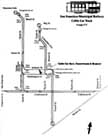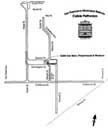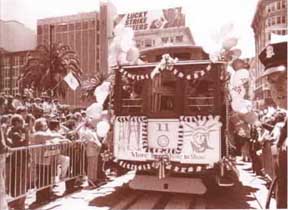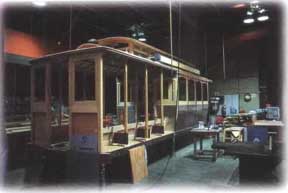 |
Today's
Cable Car System—
Andrew Smith Hallidie's Legacy |
|
|
 |
When
Today's System Began: The date was
Sunday morning December 22, 1957. The start occurred when California
Street cable car No. 51. coasted onto Washington Street from the
Washington-Mason cable car barn. When No. 51 entered service, the
current three-line (California, Powell-Mason, and Powell-Hyde),
5.09 mile (one way mileage) cable car system became a reality.
Photo: Today's system began when the California
Street line began operating from the Washington-Mason car barn.
Cal car No. 57 is pulling into the barn from Jackson Street after
a day of service. |

Photo:
A Powell St. car is shown at the Market St. turntable in August
1947. |

Muni
Runs Cable Cars: Although Muni started
transit operations in 1912, the railway did not get into the cable
car business until September 1944 seventy-one years after Andrew
Smith Hallidie had successfully tested the world's first cable
car. Muni’s cable car operation began when the City and County
of San Francisco took over the Market Street Railway and its two
run-down Powell Street cable lines.
This
acquisition left California Street Cable Railroad Company (Cal
Cable) as the City's last privately owned transit system. The
Cal Cable and its three lines (California Street; O'Farrell, Jones
and Hyde; and the Jones Street Shuttle) were shut down in July
31, 1951, after Lloyd's of London canceled its liability insurance.
Bankruptcy followed on August 13. Muni took over and reopened
the three Cal Cable lines in January 1952 |

Photo:
In August 1947, a Jones St. Shuttle car waits for transferring
passengers as an O'Farrell, Jones and Hyde car turns onto O'Farrell
St. |

Photo
above: It is 11:00 pm February 6, 1954 and the Jones Street shuttle
is about to make its "last run."
Cutting
Losses: Soon Muni discovered that
the Cal Cable lines were even bigger money losers than the Powell
Street cable lines. During 1954, to control the losses, Muni cut
the California Street line in half, ending now at Van Ness Avenue;
and the O'Farrell, Jones and Hyde line and its Jones Street Shuttle
were eliminated. In 1947 citizens had voted to "Save the Cable
Cars." However, the former Cal Cable lines were not protected
since they were in private ownership at the time of the election. |


|
Voters
Create Today's System: San Francisco
voters settled the on going cable car controversy in the June 1954
election. Proposition "J," which would have restored full service
on all five cable lines, was defeated nearly 5-3. On the same ballot,
a rival cable car Proposition "E" carried the day by a narrow margin
of less than 12,000 votes. As a result, the Powell Street system
and the one remaining segment of the former Cal Cable were consolidated
into one system.
Photos: The passage, in 1954, of ballot
Proposition "E" meant the end of the Washington Jackson cable
line. Most of this line was replaced by the new Powell-Hyde line
in 1957. |


Above
are two modern day maps: Cable Car Track (1) and Cable Pathways
(2). To see a larger, more detailed map click your mouse
on either map. |
The
New System: By December 1957, the "New
Lines" were up and running. The Powell-Mason line was unchanged.
The Powell-Washington-Jackson line was cut back to Hyde Street and
rerouted over the former Hyde Street leg of the O'Farrell, Jones
and Hyde line to Aquatic Park creating the new Powell-Hyde line.
This required the installation of a new turntable at Hyde and Beach
Streets, so the single-ended Powell Street cars could turn around.
All operation on the Cal Cable lines had been with double-ended
cars. In addition, Muni laid a new underground cable from the Washington
and Mason power house to California Street, thus rendering unnecessary
the old power house of the Cal Cable power house at California Street
and Hyde. California cars now run from the Washington-Mason car
barn. |
 |
Near
Collapse: As time progressed, the mechanical
condition of the system was becoming deplorable. Many years of neglect
had accumulated. The cars and power house were far from reliable
and perhaps bordering on the unsafe. The system was bordering on
collapse. For the system to continue to operate, it would be necessary
to renew the fixed plant, track, pulleys, winding machinery, power
house, and the cars themselves. The entire cable car system was
to be shut down for a major overhaul. September 21, 1982, was the
last day of cable car service |

Photo:
The construction for the rehabilitation program is very much in
evidence in this August 1983 photo at Powell and Market. |

Photos
above (Left): By mid-June 1983, only the chimney and exterior
walls remained, as the carbarn was almost totally rebuilt during
the 1982-84 rehabilitation program; (Center) Over a year into
the reconstruction, in November 1983, work is being done on the
barn and the underground sheave room beneath Washington and Mason
Sts.; (Right) This photo shows the construction in 1983 to enclose
the formerly open car-storage area.
Building
Anew: A combined effort of the public
and private sector resulted in the system being entirely rebuilt.
Many operating improvements were made. Rail became uniform throughout
the system, and radiuses became more comfortable. The power plant,
car barn and Museum were rebuilt from the ground up. However,
the cars themselves were only cosmetically upgraded for the most
part. Muni replaced the familiar cream and green paint scheme
of the Powell Street cars, except car No. 3, with a paint scheme
of maroon and cream reminiscent of the original Powell Street
Railway of 1888. |


|
"They're
Back": On June 21, 1984, after celebrations
earlier that month for the return of California Street and Powell-Hyde
cable cars, there were festivities celebrating the return of full
cable car service. These began with a ribbon-cutting ceremony at
Union Square, followed by a parade of cable cars up Powell Street
which was led by a U.S. Marine band. San Franciscan again could
climb "halfway to the stars."
Photo left: Part of the enthusiastic crowd
greeting the official return of cable cars, June 21, 1984 |
 |
Lots
of Riders: Ridership over the years
has been increasing. Nearly ten million passengers are carried annually
with 2.7 million revenue hours and 23.4 million revenue miles operated
annually. The cable cars are solid revenue generators used both
by San Francisco residents and by visitors to the City. The California
line has a significant commuter business.
Photo: Powell-Hyde car No. 16 with a typical
full load is climbing up the 21% Hyde Street hill. |
 |
On
the Street: The California line runs
as frequently as every five minutes. Each of the two Powell Street
lines run typically on a eight minute headway creating a combined
frequency on Powell Street of four minutes. Because of the operating
requirement that cable cars on hills must be spaced for safety reasons
at least a city-block apart, given Powell Street traffic congestion
four minutes is the minimum headway Powell cars can be run.
Photo: Heavily traveled cable cars have
a scheduled three minute headway on Powell Street. |


|
Building
New Cable Cars: When a cable car is
too worn to be operated it is replaced with a brand-new one. Cable
cars are not an "off-the-shelf" item. Muni has constructed its own
state-of-the-art cable car carpentry shop. The Railway also produces
all the required metal work, including the trucks. Every component
in a new cable car is produced by Muni or under direct contract.
Eight single-ended Powell and two double-ended
California cars have been built under this continuing program.
The newest car, California car No. 59, entered service July 31,
1998, as part of the Museum co-sponsored celebration of 125 years
of San Francisco cable cars. |
CABLE
CAR SYSTEM STATISTICS
| Number
of Vehicles |
Number
of Lines |
Round-Trip
Route Miles |
Annual
Vehicle Revenue Miles |
Annual
Vehicle Revenue Hours |
| 40 |
3 |
10.2 |
494,650 |
128,899 |
Lines
and Round-Trip Mileage: Powell-Mason -
3.1; Powell-Hyde - 4.2; California Street - 2.9
Maximum
Equipment Demand:
Weekdays
| 8
AM |
Noon |
5
PM |
9
PM |
| 19 |
26 |
26 |
21 |
Sat.
and Sun
| 8
AM |
Noon |
5
PM |
9
PM |
| 16 |
24 |
24 |
21 |
Boardings
- Fiscal Year 2000-2001:
| Average
Weekday |
Average
Saturday |
Average
Sunday |
Annual
Total |
| 22,814 |
23,483 |
21,939 |
8,312,946 |
Track
& Cable:
- 3'
6" gauge single track - 8.8 miles.
- Steepest
grades - 21%, Hyde between Bay and Francisco; 18%, California between
Grant Ave. and Stockton; 17%, Mason between Union and Green; 17%,
Powell between Bush and Pine.
- Cables
- four cables moving at 9 1/2 mph, each powered by a 510 hp electric
motor in the cable car barn, using a total of 3.7 million kwh per
year.
- Cable
diameter - 1 1/4".
- Cable
length: Powell - 9,300 ft.; Mason - 10,300 ft.; Hyde - 16,000 ft.;
California - 21,700; Total - 57,300 ft.
The
Car Barn:
Washington
& Mason Sts. (1201 Mason St.) Originally built in 1887 for the Ferries
& Cliff House Rwy., rebuilt after the April 1906 earthquake and
fire, and again rebuilt in 1982-84. Facility square footage: 84,741
sq. ft.
The
Vehicles:
| MODEL |
SERIES |
NO. |
LBS. |
L. |
W. |
H. |
CAP.* |
| Powell |
1-28 |
28 |
15,500 |
27'
6" |
8' |
10'
4 3/4" |
29/60 |
| California |
49-60 |
12 |
16,800 |
30'
3" |
8' |
10'
2" |
34/68 |
| |
TOTAL |
40 |
|
|
|
|
|
* cap.
- seated/total optimum capacity
SF
Muni Communications Department
February 7, 2002
| Back to the
Museum's Home Page |
 |
|